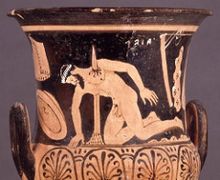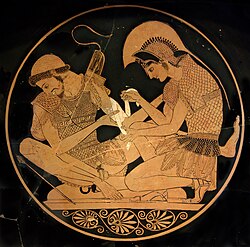
Back Àiax (Sòfocles) Catalan Aiás (Sofoklés) Czech Ajax (Sophokles) German Αίας (τραγωδία) Greek Áyax (obra) Spanish آژاکس (سوفوکل) Persian Aias (Sofokles) Finnish Ajax (Sophocle) French Aias Frisian איאס (סופוקלס) HE
| Ajax | |
|---|---|
 The Suicide of Ajax. Etruscan red-figured calyx-krater, c. 400–350 BCE. Currently in British Museum (1867,0508.1328) | |
| Written by | Sophocles |
| Chorus | Sailors from Salamis |
| Characters | Athena Odysseus Ajax Tecmessa Messenger Teucer Menelaus Agamemnon |
| Mute | Attendants Servants Soldiers Eurysaces |
| Place premiered | Athens |
| Original language | Ancient Greek |
| Genre | Tragedy |
| Trojan War |
|---|
 |
Sophocles' Ajax, or Aias (/ˈeɪdʒæks/ or /ˈaɪ.əs/; Ancient Greek: Αἴας [a͜í.aːs], gen. Αἴαντος), is a Greek tragedy written in the 5th century BCE. Ajax may be the earliest of Sophocles' seven tragedies to have survived, though it is probable that he had been composing plays for a quarter of a century already when it was first staged. It appears to belong to the same period as his Antigone, which was probably performed in 442 or 441 BCE, when he was 55 years old.[1] The play depicts the fate of the warrior Ajax, the second greatest hero at Troy (after Achilles), after the events of the Iliad but before the end of the Trojan War.
- ^ Finglass (2011a, 1–10), Harsh (1944, 91), and Moore (1969); Golder tentatively dates the play to 445–440 BCE (2010, 19); Woodruff states that "Women of Trachis and Ajax are generally considered fairly early" (2007, xiv); Watling argued that the "general shape and style place Ajax among the earlier works, and its position, in the oldest collections, at the head of the list, indicates a strong tradition of its having been the earliest of the extant plays" (1953, 7); Jebb argued that Ajax is later than Antigone (1896a, li–liv).
© MMXXIII Rich X Search. We shall prevail. All rights reserved. Rich X Search